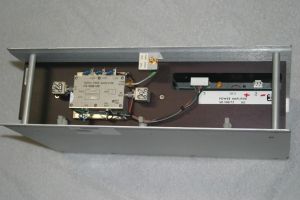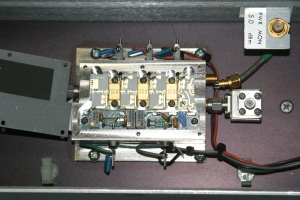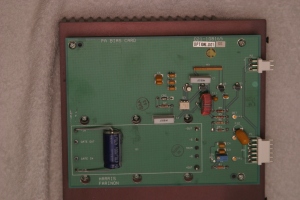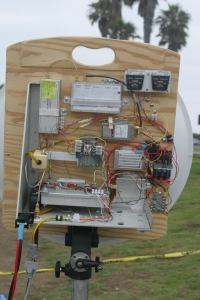The ARRL 10GHz and Up contests are coming up soon (August 17 to 18 and September 21 to 22), so I thought I’d re-publish my article that originally appeared in The Proceedings of Microwave Update 2005.
The Harris-Farinon Model SD-108175 / 076-108687-001 solid state power amplifier (SSPA) has been seen globally on the surplus market over the last few years. This amplifier is a part of a large rack of equipment running on the traditional 24VDC, positive ground telecom power system bus.
In its original form, the amplifier is very robust and heavy, since it is rated for continuous duty, Class A operation. Figure 1 shows the unit as received. It is mostly heatsink, and the RF unit, where the microwaves are amplified, is the tiny silver box on top.
The SSPA unit (Model SD-108175) measures about 15-1/2 inches wide, 4-1/4 inches high and 10 inches deep, and weighs over 15 pounds. The little silver box (part number 076-108687-001) with SMA isolators at the input and output, is about 3 inches wide, 1 inch high and 2-1/2 inches deep.
Important: Be careful if you see these units for sale, I have seen some inaccurate descriptions of these units – for ham radio use, the only item we want is just the amplifier (076-108687-001) and not the heatsink/chassis assembly or the power supply DC-DC converter.

Figure 1. The Harris-Farinon 10GHz amplifier is very beefy, but it is mostly heatsink. The little silver box is where the RF is amplified.
I took the unit to Dave Glawson’s lab (WA6CGR) to see if we could integrate this SSPA into my X-band rig. It is a 1W unit, but I have several that put out as much as 3W on 10368 MHz. I purchased several of these units at a very reasonable price, and am pleased with their performance on the 10 GHz Amateur Radio band.
The terminals on the amplifier as well as the power supply PCB are marked, simplifying some of the guesswork about what-goes-where. The amplifier includes a “POWER MON” SMA female jack, which should probably be capped with a 50Ohm termination to prevent oscillations or weird things from happening while the amplifier is operating. A “DET OUT” pin is useful to verify amplifier operation.
It may be prudent to read Chuck Houghton’s article, “Above and Beyond, Microwave Stripline Retuning Procedures” on tweaking circuits before any “poking around” is done on any SHF amplifier, to prevent damage. Links to references are at the end of this article.
The first step is to power it up and verify operation in its “as-is” state. With about +17dBm (about 60mW) input, power output is about +35dBm, or a little over 3W at 10368MHz. Current consumption is about 2.6A during standby and about 3A at 10V with RF applied. Dave and I wondered whether or not we could tweak the amplifier to get more power out, so we took a look under the lid of the little silver box, see Figure 2. We decided not to tweak anything inside the tiny box.

Figure 2. A peek inside the SSPA. No tuning is required to get two to three watts output on 10368MHz.
Since the amplifier passed its first tests, the next step is to re-package the unit so it would be more suitable for portable and roving operations. Certainly, a weight reduction could be done by shrinking the size of the RF module heatsink, and adding a fan or two.
Since the amplifier passed its first tests, the next step is to re-package the unit so it would be more suitable for portable and roving operations. Certainly, a weight reduction could be done by shrinking the size of the RF module heatsink, and adding a fan or two.
The DC-DC Converter
The original power supply board appears in Figure 3. A casual inspection of the unit showed that the 24V input was buck-regulated down to 12V, and then further reduced to minus 2.1V for the bias and +10V for each stage in the amplifier. The DC-DC power supply looks like it can be modified and re-used, by applying 12VDC where the brick converter has its output. However, this modification was not attempted.

Figure 3. The DC-DC supply board. A 24V to 12V brick converter is mounted to a 14-1/4 inch by 7-1/4 inch heatsink under the PCB. The existing DC-DC converter may possibly be modified to make the unit work on 12VDC input. See text.
I thought a better, lighter, more modern power supply could be built fairly easily, and the large heatsink for the power supply could be deleted.
With Dave’s help, I made a simple DC-DC converter using a Linear Technology LT-1083 adjustable regulator and a few resistors for the +10V supply. The negative bias supply was made from a surplus 99-cent DC-DC converter. I built the power converters into separate chassis boxes, since I had them on-hand. A single box is also acceptable.
Like all FET power amplifiers, one must make sure that the minus (gate) bias supply is always connected before the supply voltage to prevent damage to the devices. I am sure there are several solutions for power-on sequencing to prevent this from happening, including relay or other switching or timing schemes. However, I chose a very simple route: I simply wired the minus voltage directly to the amplifier bias feed-thru capacitor, with no switching in-between. The plus 10V supply line is switched to the amplifier via a power relay, actuated by the sequencer. This way, whenever the rig is powered up, the minus bias voltage is “automatically” applied (it was never off in the first place), and the plus 10V is applied only when the rig is put into transmit mode.
I had a pair of 24V brushless DC motor fans in the junk box, so I am using these to blow on the heatsink. Since I have both 24V and 12V running around in my rig, I wired up a two-speed fan control using a pair of spare relay contacts. When the radio is in the receive mode, 12V is applied to the fans, reducing the noise. When the rig goes into transmit mode, 24V is applied to the fans, running them at full speed.
The final result is shown below. The amplifier is mounted in one of my 10GHz rigs, “Ms. June.” 3 The SSPA puts out 2W at the antenna port, and now measures about 4 inches by 7 inches by 1-1/2 inches, including the cooling fans. A re-labeled, surplus CB panel meter (1mA movement) connected to the DET OUT pin indicates SSPA operation. (Update: Ms. June was cannibalized for parts. However, many of her parts were used in other radios, including my latest, record-setting 10GHz transverter.)

Figure 4. The Farinon SSPA installed in “Ms. June,” one of my early 10GHz rigs. Two watts appears at the waveguide port at the antenna relay in transmit. The DC-DC converters are enclosed in separate chassis boxes, and can be seen just to the right of the amplifier. A re-labeled surplus meter monitors amplifier operation.
References
1 – “Above and Beyond, Microwave Stripline Retuning Procedures,” by C. L. Houghton, WB6IGP, San Diego Microwave Group:
http://www.nitehawk.com/rasmit/mstrp_tu.html
2 – The surplus TDK DC-DC converter is described as a “5V in +/-5V DC/DC converter” at MPJA Online, as part number 1042518. This unit is under a “closeout” deal, so supplies may be limited. Go to http://www.mpja.com, and look under “Power Supplies,” “DC-DC Converters.” Their phone number is 800-652-6733, 9AM to 5PM Eastern Time, Monday through Friday. Although probably not necessary, I removed the TO-220 device from the board and re-mounted it to the metal chassis box for heat-sinking.
3 – Most of the SBMS members have names for their rigs, mainly because, as many of you know, microwave radios tend to have personalities of their own. Ms. June is my sixth 10GHz radio re-build. “Morpheus” was my first attempt, see CQ magazine for December 2003 and January 2004 for my dubious start on the microwave bands.
Wayne, Nice write-up. I’ve built up a couple of these 1 – 3 W 10 GHz amps and find they work very well. Any idea of where a person might come by any more of them. I have one left (076-108164-001). Would like to have several more and a few of the 076-108687-001 models if they can be had for a reasonable price.
CU 73, Dave…
Dave – Thanks for your comments. I usually find those amplifiers on eBay, although I managed to find some locally from a telecom surplus outfit nearby. I have a notification set up on eBay for these and other items for my microwave ham projects. 73 and good DX, Wayne KH6WZ
Hi Wayne, since you published you notes on the Harris 10ghz 4W PA have you done any more experiments with it ? I have just bought on and am about to test it, but I have limited test equipment ie power measurement !
Any thoughts ?
David Storrs
G8gxp
David –
No more experiments have been needed on the Harris amp. They will do from 1W to 3w out of the box with no tuning needed…
I suggest you locate a friend with the proper test gear to give it a test – that’s the best way.
73 and thanks,
Wayne KH6WZ
All.
I purchased one of these amplifiers on Ebay from the far east. Last week I have it up and running on 10ghz. I note that the supplier on Ebay quotes you can use a 7660 to generate the required negative voltage but I found this device was not suitable as its only capable of supplying 20ma max. From starting tests done on my amplifier using a bench variable PSU I note the bias requierments..
-2.1 volts 23ma
-2.5 volts 27ma
-3.0 volts 34ma
-4.0 volts 45ma
-5.0 volts 60ma
I settled to use a MAX764 device to generate -5v and adjust the three bias set pots for a quiescent current in the two driver stages of 1amp each and for the final device 1.2amps. The MAX764 is rated to 250ma and so seems a more suitable device. You could set the 764 for -2.1volt if you wish which is what I believe the Harris originally used. My amp is now working producing more output than the 1w amp it replaced but I lack suitable test gear to accurately measure the out going power. Does anybody here know if my quiescent current settings are optimum?
73 de Denis G3UVR
Denis – Thanks for posting the additional data on this amplifier. I did not do much measuring and recording of data, I usually do enough testing and tweaking to get things to work. I have two more of these small amps in my stock, and am building another 10 GHz system slowly. I will try to take time to make more measurements as I get there.
Thanks and 73,
Wayne KH6WZ
Hello Wayne, I have a Harris 076-108164-001 and I wounder do you know anything abt -Vgate on that one? //Ronny SM7FWZ
Bonjour,
Je sors 2.2 watts avec un courant de Drain de 1 ampère par transistor.73 de F1HCN
Roger
Roger – VY GUD! 73 es TNX de KH6WZ Wayne
Is the bias voltage critical and would -3 volts work? I have a Texas Instruments PTN78000a but lowest It goes down to, is -3 volts.
I think the bias voltage is in a range, but I do not have it off the top of my head., -3V should work – but the critical thing is to make sure the power sequence is correct, never apply the minus voltage before the plus. As mentioned, I solved this easily and it is goof-proof — always have the minus voltage on and connected to the amp at all times. 73 and good DX on the band!
Pingback: QSO Today Online Expo August 8, 2020: More 10 GHz Information | wayneyoshidakh6wz
Quick correction to your comment from August 5 2019. “… never apply the minus voltage before the plus. ” Should that not be the other
way around ?
Hugh –
YES! Thank you for the important correction. It’s my dyslexia / dyscalculia kicking in. The MINUS voltage (gate bias) MUST be on before the plus voltage!
BTW, W1GHZ’s valuable microwave ham radio site has a good article on GaAsFET bias circuits for preamps (LNAs) as well as power amps:
http://www.w1ghz.org/10g/bias.htm
73 and TNX!
Wayne KH6WZ
Hi Wayne, What should I expect to pay for Harris amplifier 10ghz part 076-108687-001? Where is a good place to find one of these? I have been looking on Ebay for quite some time with no luck. However I found one on a website selling for $500.00 at https://www.re-spareparts.com/products/supply-harris-amplifier-10ghz-10v-sma-076-108687-001.
Any comments would be appreciated. Regards Tom KG6CSE
Tom, pricing on surplus items is all over the map. I guess it is a **perceived** value and prices are set based on who would buy them at xxx price. To be honest, I bought mine at a much lower price. I would continue to watch the transactions and see if prices go down. The seller has more than one available.
I have a eBay alert set for this item, but I do not need any more, so I usually ignore the updates.
There are plenty of other SSPAs for 10 GHz coming out, so you may want to broaden your search to find 10 GHz amps in a more generic sense.
Also, reach out to the uWave community via the message boards and clubs – there is usually someone who bought something you need, and the owner chnages his mind . . . .
Good luck and 73,
Wayne KH6WZ
Has anyone corroborated G3UVR Denis’s quiescent current readings, 1A for each of the drivers and 1.2A for the final ?
73, Hugh VA3TO